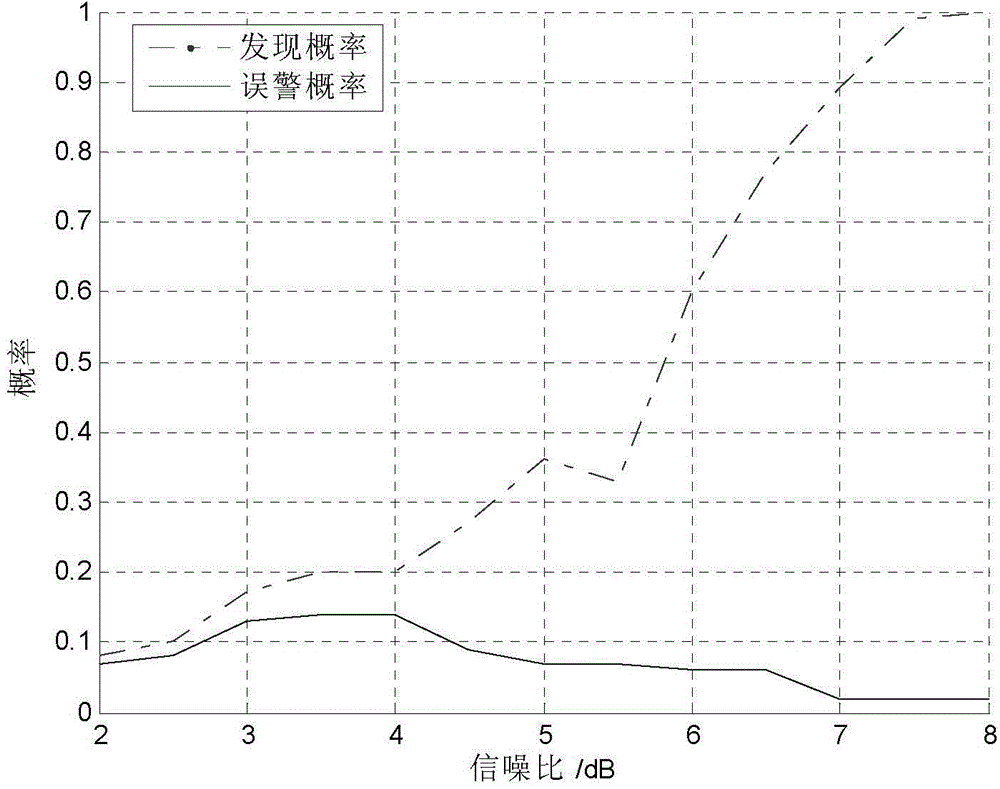Anti-transfer deceptive jamming method based on Relax algorithm
A deceptive jamming and forwarding technology, applied in satellite radio beacon positioning systems, measuring devices, instruments, etc., to solve problems such as single, inability to solve results, and rejection of signals
- Summary
- Abstract
- Description
- Claims
- Application Information
AI Technical Summary
Problems solved by technology
Method used
Image
Examples
specific Embodiment approach 1
[0029] Specific embodiment one: a kind of anti-transfer deception interference method based on the Relax algorithm of the present embodiment is specifically prepared according to the following steps: Step 1, according to the iterative formula of the Relax algorithm, calculate the DOA and the amplitude of N GPS signals value where n=1,2...N; is the amplitude value of the detected nth GPS signal K at the moment; is the DOA estimate of the nth signal detected;
[0030] Step 2. According to the object we observe, it is the amplitude value of the signal detected by the Relax algorithm Calculate the threshold V of the GPS signal T , and sets the absolute threshold V ab , the setting of the absolute threshold is to solve the situation that the detected GPS signals are all interference signals;
[0031] Step 3, obtained according to Step 1 Calculate the amplitude observation z of the GPS signal n :
[0032] z n = ...
specific Embodiment approach 2
[0046] Specific embodiment two: the difference between this embodiment and specific embodiment one is: in step one, according to the iterative formula of Relax algorithm, calculate the DOA and the amplitude value of N GPS signals The specific process is:
[0047] A, setting N is the number of the GPS signal detected by the Relax algorithm, M is the number of elements of the array antenna receiving the GPS signal, K is the instant number of snapshots, and x (k) represents the receiving matrix of the GPS signal at k moments, then The receiving matrix of GPS signals at K moments is X=[x(1)x(2)...x(K)], and the iterative formula of the established Relax algorithm is as follows:
[0048] x n ( k ) = x ( k ) - Σ i = 1 , i ...
specific Embodiment approach 3
[0057] Specific embodiment three: the difference between this embodiment and specific embodiment one or two is: in step two, the object we observe is the amplitude value of the signal detected by the Relax algorithm Calculate the threshold V of the GPS signal T The specific process is:
[0058] The distribution of the amplitude value of the signal detected by the Relax algorithm is generally considered to be a Rayleigh distribution; now we make two assumptions H 0 : The detected signal is a real GPS signal; H 1 : The detected signal is a deceptive interference signal, then the false alarm probability is:
[0059] P f = ∫ V T ∞ u σ s 2 e - u 2 / ...
PUM
 Login to View More
Login to View More Abstract
Description
Claims
Application Information
 Login to View More
Login to View More - R&D
- Intellectual Property
- Life Sciences
- Materials
- Tech Scout
- Unparalleled Data Quality
- Higher Quality Content
- 60% Fewer Hallucinations
Browse by: Latest US Patents, China's latest patents, Technical Efficacy Thesaurus, Application Domain, Technology Topic, Popular Technical Reports.
© 2025 PatSnap. All rights reserved.Legal|Privacy policy|Modern Slavery Act Transparency Statement|Sitemap|About US| Contact US: help@patsnap.com



